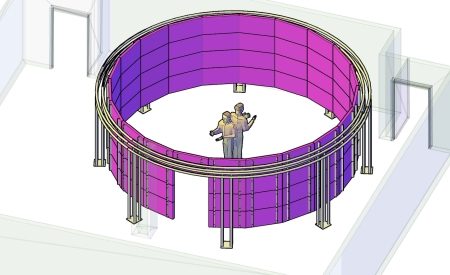September 11. 2011
Developers: Andrew Johnson, Maxine Brown, Jason Leigh, Tom Peterka, Luc Renambot, Lance Long, Jonas Talandis, Daniel Sandin, Alan Verlo
CAVE2, is a scientific instrument that enables researchers to visualize data in a fully immersive 3D stereoscopic environment; it serves as the lense of a “telescope” or “microscope,” enabling them to see their e-science datasets that reside in cyberspace. Its development is being funded by the National Science Foundation’s Major Research Instrumentation (MRI) program, award # CNS-0959053, for the period May 1, 2010 – April 30, 2013.
Upon completion, CAVE2 will be the world’s first flat-panel-based, high-resolution CAVE – i.e., Cave Automatic Virtual Environment, which the Electronic Visualization Laboratory (EVL) at the University of Illinois at Chicago (UIC) built and successfully commercialized in the 1990s. The original CAVE was a 10x10x10-foot room within a room, with a resolution of 4 Megapixels and a cost of about $1M. CAVE2 provides potentially 10 times the stereo resolution at half the cost. This is achieved by using the latest near-seamless, flat-panel, passive-stereo, LCD technology to create a multi-person collaborative space.
CAVE2 benefits large-scale collaboratories of discipline scientists in need of advanced cyberinfrastructure. Today, all science is e-science: computers capture, filter, analyze and visualize data from instruments and simulations. EVL has longstanding partnerships with a number of leading scientific research and education organizations – computer-science communities, domain-science communities, government laboratories, museums, and corporate research – who have built many of its prior visualization systems, and have provided EVL with feedback on new requirements based on their evolving scientific needs. EVL truly believes it can transform their workflows by providing them with new and more intuitive ways of interacting with their data.
In addition, CAVE2 benefits computer scientists, enabling them to study a wide range of new problems at the intersection of human-computer interaction, virtual reality, computer graphics, high-performance computing, high-speed networking, and computer-supported cooperative work, with the goal of providing better ways to help knowledge workers manage scale and complexity in their research.
This MRI enables EVL to continue to provide state-of-the-art visualization instrumentation to research scientists and educational opportunities that enhance UIC graduate and undergraduate education. EVL’s MRI-funded instruments are developed by its faculty, staff and students, and used by approximately 11 EVL-affiliated UIC departments in Computer Science, Geoscience, Medicine, Communications, Education, and Art. These instruments enable graduate students to conduct research toward their degrees, and attract and inspire undergraduates to pursue graduate degrees. Additionally, EVL has engaged scores of children through its outreach efforts with the public schools and museums.
